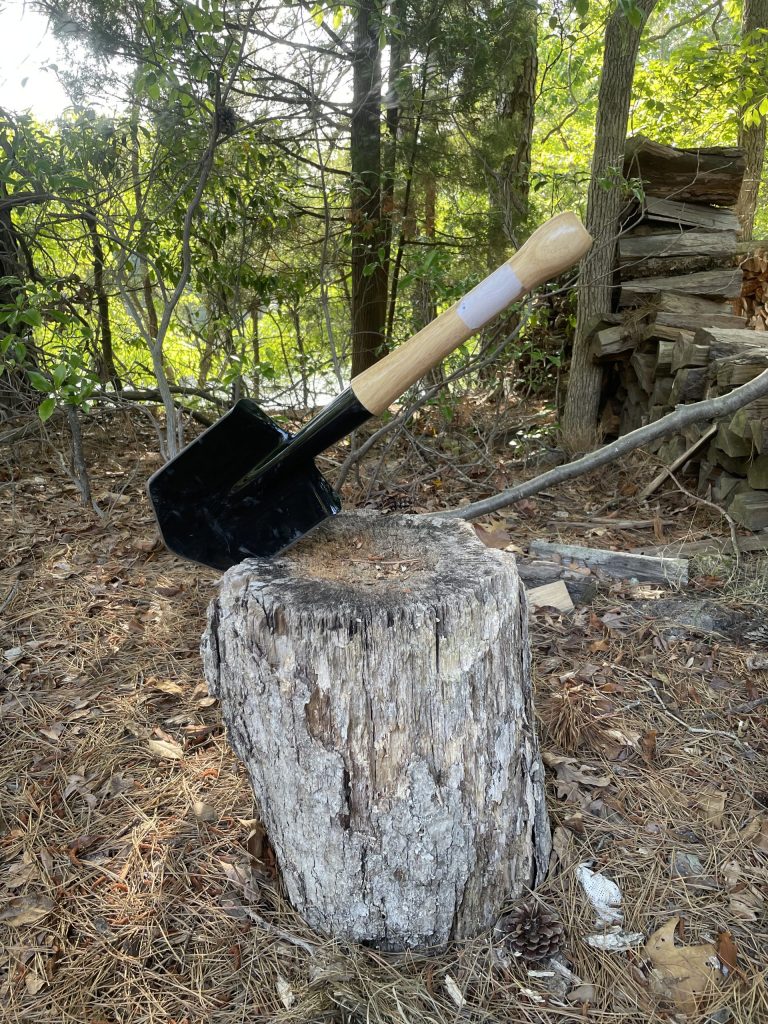
Every. Single. EDC. List. Every single one – is led with a knife. Everyone out there, everyone (fact check me on this) agrees that a knife is basically the most versatile and useful tool you can carry.
I wholeheartedly agree.
“We” are not the first to observe this. Countless others have observed as much, and it’s the reason that so many people don’t go out of the house naked of a knife, to borrow a sort of expression from Steinbeck.
Who are some people that extolled the virtues of the knife as a multi-purpose, bladed tool? How about Horace Kephart, who spent large portions of his life in the wilderness, and George Washington Sears, better known as Nessmuk, who allegedly always carried two knives and a hatchet.
We can throw hatchets and axes in that bin, too. They’re highly useful tools.
You know what tool almost never makes the list of EDC essentials? A shovel.
This is somewhat fair. No one’s back pocket is big enough for a shovel, even a folding entrenching tool.
But why don’t shovels make more lists of important EDC gear?
Good question, and it’s one I’ve been thinking increasingly about after getting my hands on a Cold Steel Special Forces Shovel, which is one of the coolest pieces of gear in my tool kit, and honestly one of the most useful.
I am so surprised by the versatility and capability of this tool that I feel compelled to write a review about it.
This little shovel is great. It can do most things a knife can do, some things an ax or hatchet can do, and plenty of things you wouldn’t want to use either to accomplish.
A bit of backstory. I got one of these shovels for a great price (I think from Amazon, for less than 20 dollars, but, if you want to get one I suggest you check out either Midway.com or SMKW.com because both have excellent prices which are usually better than Amazon’s.) because I had previously been working on a quinzhee in the wake of a Nor’easter we had here at the end of last January.
I was previously using a folding entrenching tool to help me excavate snow and carve out the inside of the quinzhee, and I just couldn’t help but think that there must be tools that are better equipped for the job.
Folding shovels, which are very versatile, can be opened completely or locked at right angles. This makes them useful as shovels but also as picks or sort of as mattocks for clearing earth and snow.
They’re useful, but the ergonomics could be improved. While I was using the folding shovel, I just couldn’t help thinking, “there has to be a better tool for this.”
And my mind wandered to the Cold Steel Special Forces Shovel that I’ve seen advertised so many times.
So I got one; and it was so great I got another. Here’s what I learned.
Cold Steel Special Forces Shovel Specs
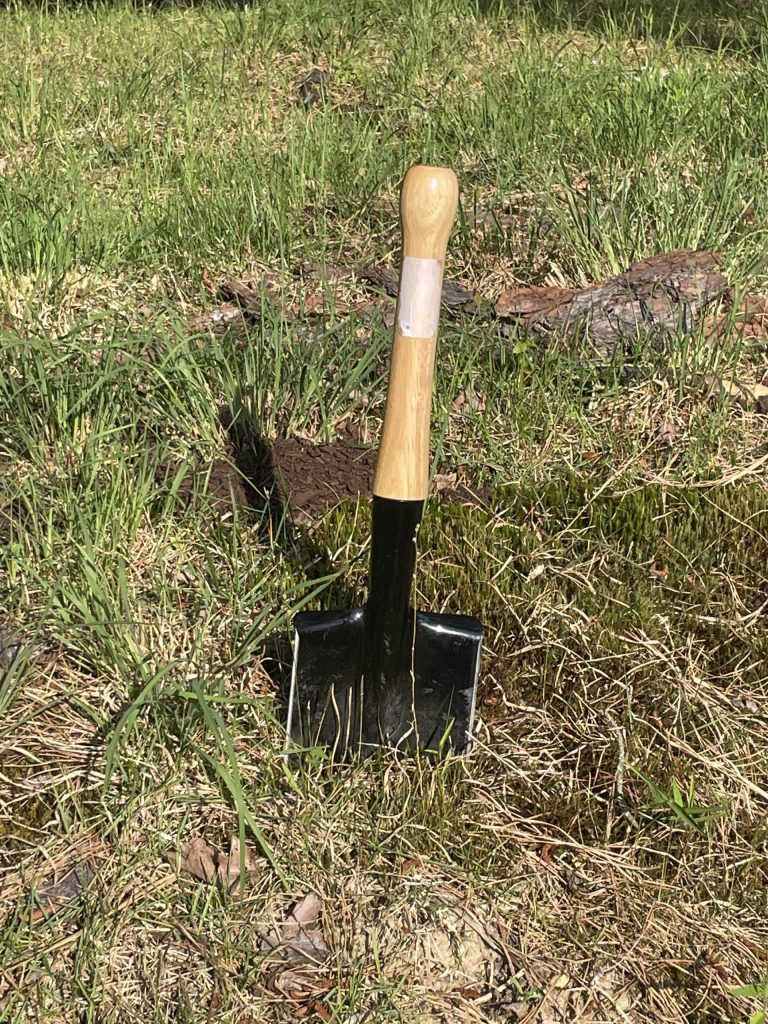
I broke down and ordered one of these things a few months ago.
Cold Steel says that its “Spetsnaz” Special Forces Shovel is modeled after a Soviet Spetsnaz military entrenching tool.
Cold Steel claims the handle is hardwood (probably hickory), the steel is “medium carbon” (whatever that means), is 25.7 ounces, 19.68” long (there is another model with a longer hardwood handle), and has a 2mm thick blade.
That’s it for official specs. Cold Steel also makes a special, MOLLE-compatible sheath for this shovel as well as a version with a longer handle, but I have as yet not indulged in these.
There are a lot of things that are unique about this shovel that I find interesting and utilitarian.
One is the size. This thing is deceptively heavy, in fact. It’s only officially 25.7 ounces but it feels a lot heavier when you’re swinging it, probably because of the length. As a result, it swings like a small hatchet or ax, but is still light enough to carry on a backpack without being obtrusive.
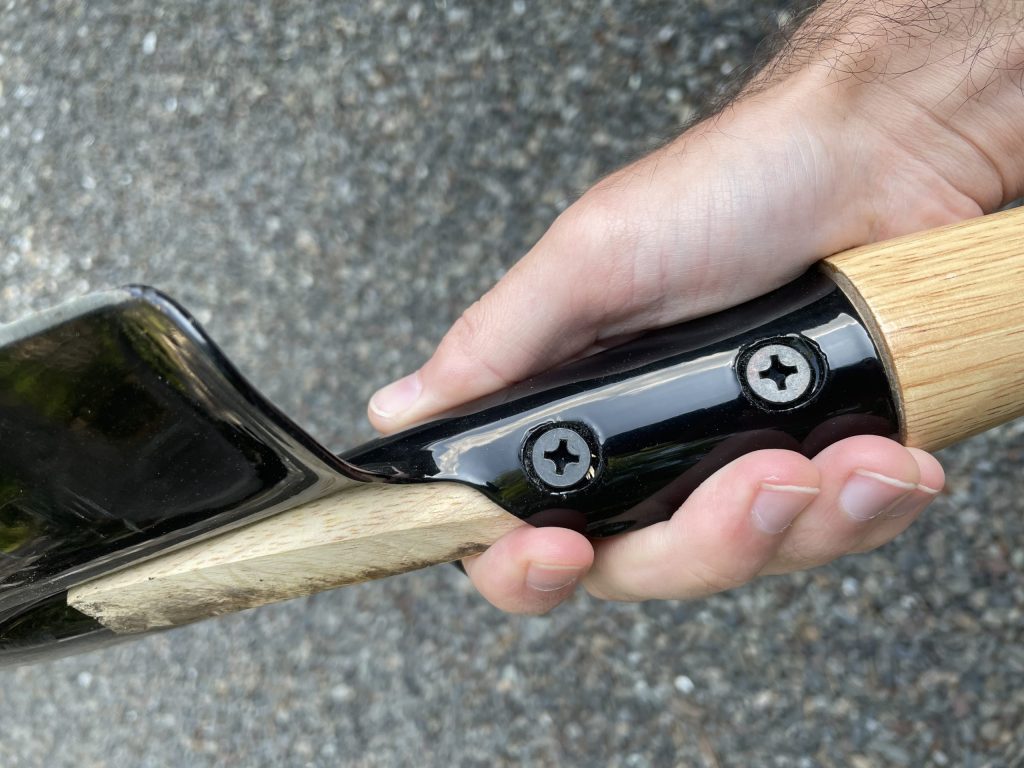
The handle is fixed to the blade via the aid of two screws, which is a nice feature because, unlike rivets, they can be replaced much more easily if the handle breaks or the collar gets deformed or something like that.
The vast majority of shovels today are made with D-handles. This makes them useful as scoops and gives your digging arm more leverage and lifting power. However, this shovel lacks a D-grip and instead is made with a palm swell at the back of the handle. This makes the shovel a lot more versatile overall, for digging, cutting, chopping, hacking, prying, swinging – you name it.
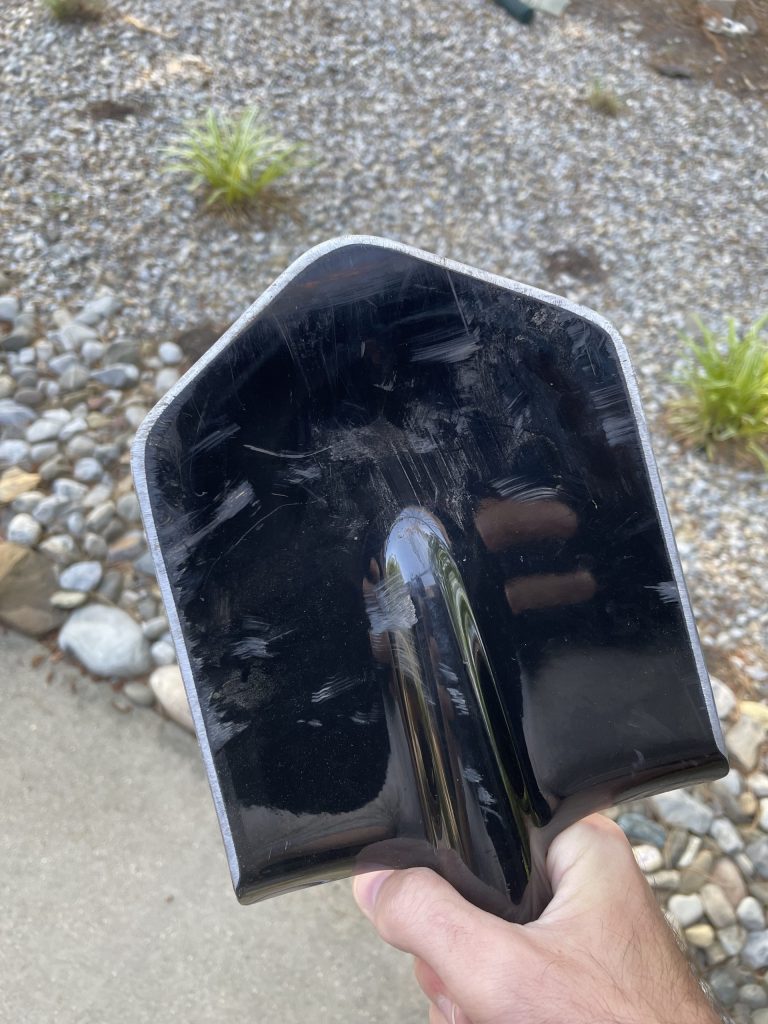
The blade is a basic spade shape but it has angled corners instead of two rounded bellies that come to a point. There is also a sort of step at the top of the blade that can be used for leverage while digging, although this shovel is a little bit small for that.
The blade comes sharpened, somewhat unevenly, I might add, but with a little elbow grease it can be made quite sharp, which gives this shovel the unique ability to be used as a carving, chopping or cutting tool and not just for excavation and material removal.
Now let’s cover steel and wood quality before we dive into what makes this shovel such a great piece of equipment.
Steel Quality
I find that interesting because Cold Steel and all other knife manufacturers worth their salt are religious about divulging steel chemistry. In an increasingly discerning market, steel composition is often the factor that decides a purchase.
I suppose the people that use shovels on the daily are a little less hardcore about the sort of steel that forges use to make them, but I digress somewhat.
Here is what I think, based on having used this shovel for light duty for a few months now. I think it’s made with 1055 carbon steel.
Why do I think this? Because I have three Cold Steel Trail Boss Axes and that axe is made with 1055. Also, the two tools appear to be finished with the same baked-on paint and to have been ground in the same fashion.
If I had to assume, the same facility makes them both. (By the way, the Cold Steel Trail Boss is the best ax I have ever laid my hands on. I have three and have felled multiple trees and split cords and cords of wood with them. That’s another Cold Steel product with a review coming down the pipeline.)
But wait, there’s more (to my assumption, that is). These tools are both made for similar tasks, so it sort of makes sense that Cold Steel would use 1055 steel for this shovel. It’s also a “medium carbon steel” so it hits that mark too.
Here’s the thing. Axes, like shovels, are often abused, swung, used for prying, splitting, digging, chopping, and a whole bunch of other unholy and unyielding, demanding tasks.
You need a tough steel for that, and 1055 is the perfect alloy for that calling.
Basically, 1055 steel is iron with about .55% carbon in the mix, which I believe is where the .55 in the name comes from (similar to 1095, which has 95%, and to 1045, which has .45% carbon, respectively).
The more carbon in an alloy, the better the steel will adapt a rigid structure when heat treated properly. In other words, the more carbon there is, the harder the steel can be made.
Super hard steel is not a good thing for a tool like an ax, or a pick, or a shovel for that matter. Softer, tougher, and stronger is better. If you hit a rock, you want the edge to roll or ding; you don’t want the whole thing to shatter, or the edge to chip or crack.
For this reason, striking tools (like shovels and axes) are typically made with relatively soft steels that can tolerate the impulse of impact without breaking. The higher iron-carbon ratio makes them softer, but tougher and stronger.
Some axes have what is called a differential heat treatment, in which the bit is intentionally hardened to a higher rating than the poll. This gives the axe the best of both worlds; a strong, hard, sharp bit, and an overall head of steel that is unlikely to break.
Perhaps Cold Steel has performed a differential treatment in this shovel. I don’t know.
Here’s the other thing. This shovel produces a pleasant ring when struck against other hard objects. It’s a relatively low-pitched ring, and not too glassy, which means that the steel is somewhat soft. This backs up my assumption that it’s some sort of medium-low carbon alloy like 1055.
Is it? Who knows. Perhaps Cold Steel will be good enough to let us know and I can amend this post.
Till then, here’s my assessment: The steel is strong and very tough, sort of soft along the edge, but this is a shovel, not a file. It gets high marks for that.
Handle Quality
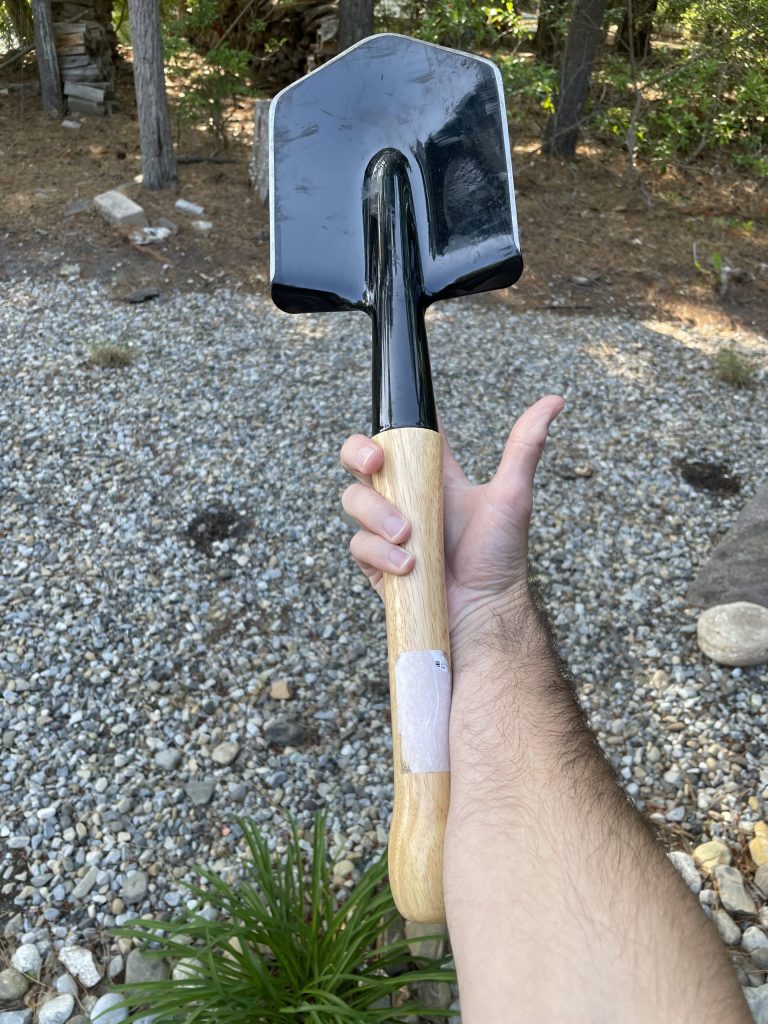
Now lets talk about the handle which is well designed but which also leaves a little bit to be desired.
I love the fact that Cold Steel has used a hardwood in the construction of this axe. It’s not explicitly stated what wood they use but I have to assume it’s hickory. I do know they use hickory for some of their other tools so it makes sense they’d use it here, but I can’t prove that.
There are no cracks or blemishes in either of the two Cold Steel Special Forces Shovels I purchased, but Lord on high, the grain orientation is piss-poor.
Not only is it uneven, but there is a ton of runout. Not a good look for a producer of premium tools. It would be completely unusable in an axe or a full-sized shovel or other hafted tool.
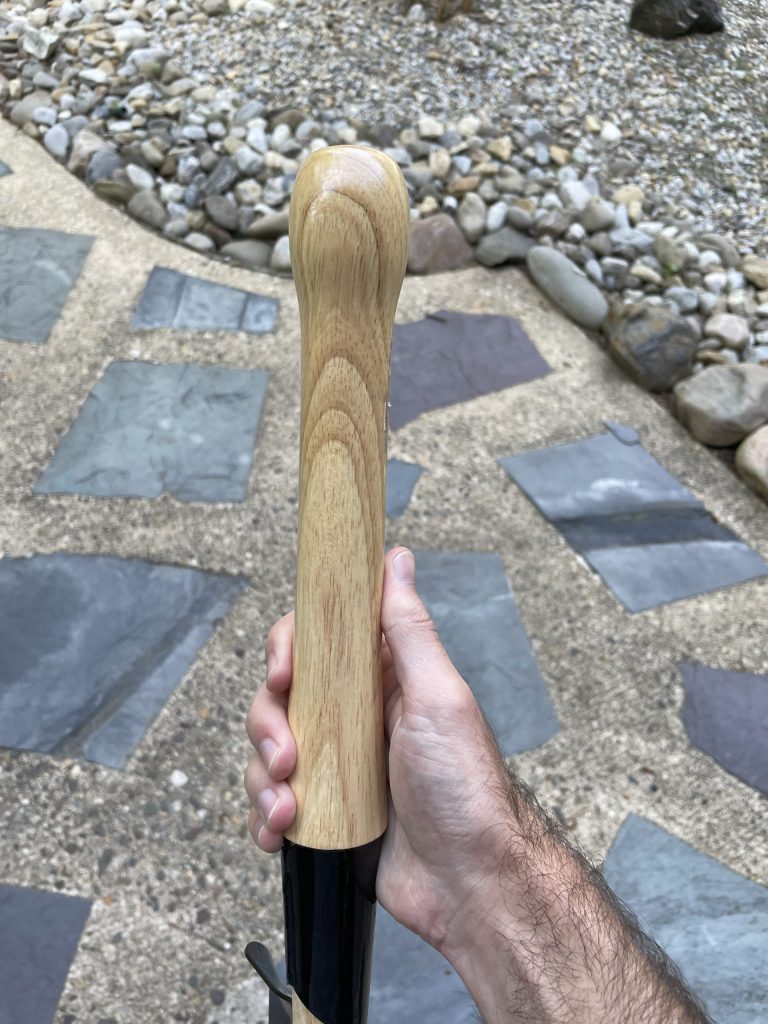
Here’s the good news. Even though I absolutely hate the terrible quality control that led to this shovel being made with a less than optimal piece of wood, it really doesn’t matter. The handle is very beefy, and the tool is so short, it would take a force of nature to crack this handle. At least, it’ll take a force of nature to which I’m not going to subject this shovel. That is perhaps a topic for another day.
So, even though the handle has horrid grain orientation, the tool is so short that it’s legitimately not a big deal.
I also feel like the tool is awkwardly short. It’s too small to be used for intense excavation or to be used as a splitting maul. I mean, it can be used for those things, but it takes a disproportionate amount of elbow-grease from the wielder. That is the price of small size and convenience.
But there are definitely some things I really do like about the handle. I love the fact that it’s not too thin. In fact, it’s quite full bodied and fills my grip very comfortably.
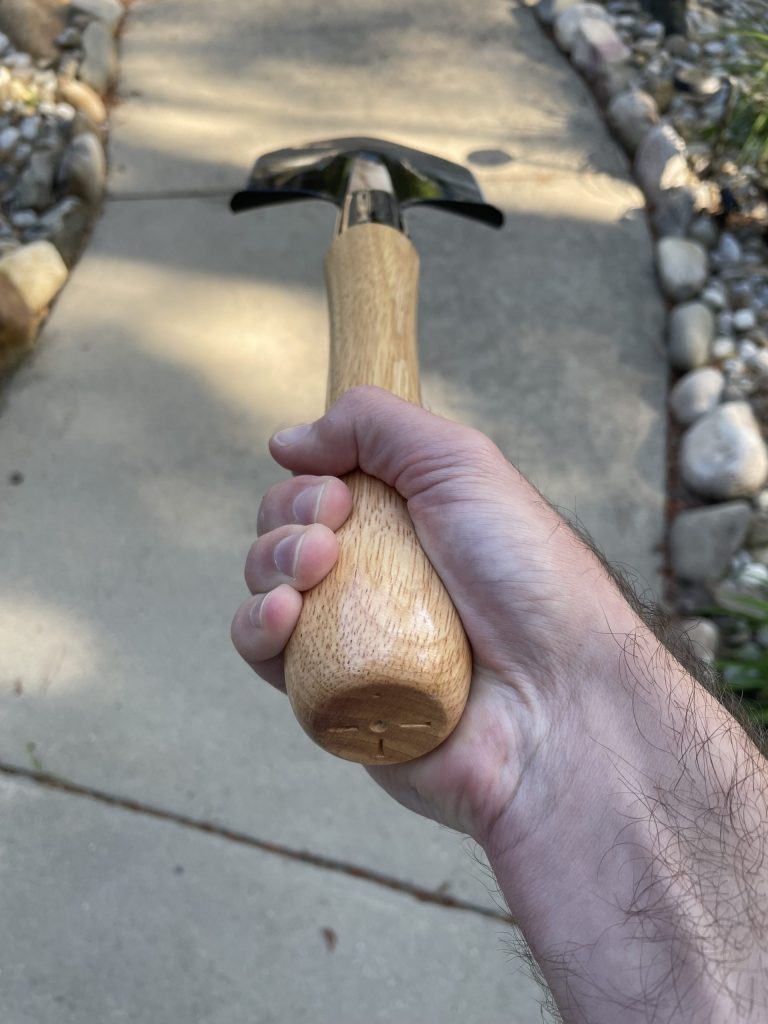
I also love the swell at the end of the handle that helps keep the shovel in your hand, even when you’re swinging it. That’s a big deal and really aids in retention and control of the tool.
Some others have noted that the handle is slippery and uncomfortable to use with sweaty hands. I’ll admit, I haven’t used this tool for heavier enough work to notice yet, but they might have a point. It is a slick handle.
If you’re really concerned about tool retention, what you can do is drill a hole through the end of the handle and pass a lanyard through it. I don’t think it’s necessary but it would solve a few problems for some users, and some people are just lanyard happy, so do what works for you.
I read some other reviewer commenting that he wrapped the handle in cord. That would probably work, but there’s no easy way to secure it to the handle in a manner that won’t slip up and down.
Instead, it might make more sense for you to wrap the knob, or near the knob, in electrical tape, duct tape or athletic tape. It would be ugly as sin, and the adhesive would leave some unsightly marks on the finish of the wood, but this is a tool, not an entry in an art gallery. Do what works for you.
Things You Can Do with the Cold Steel Special Forces Shovel
There is so much I love about how this shovel handles and what it can be used for.
Let’s start with the obvious. This shovel is a digging machine. Its sharpened edge, which can of course be touched up by the user, can slice and dice through roots with ease, even thick ones.
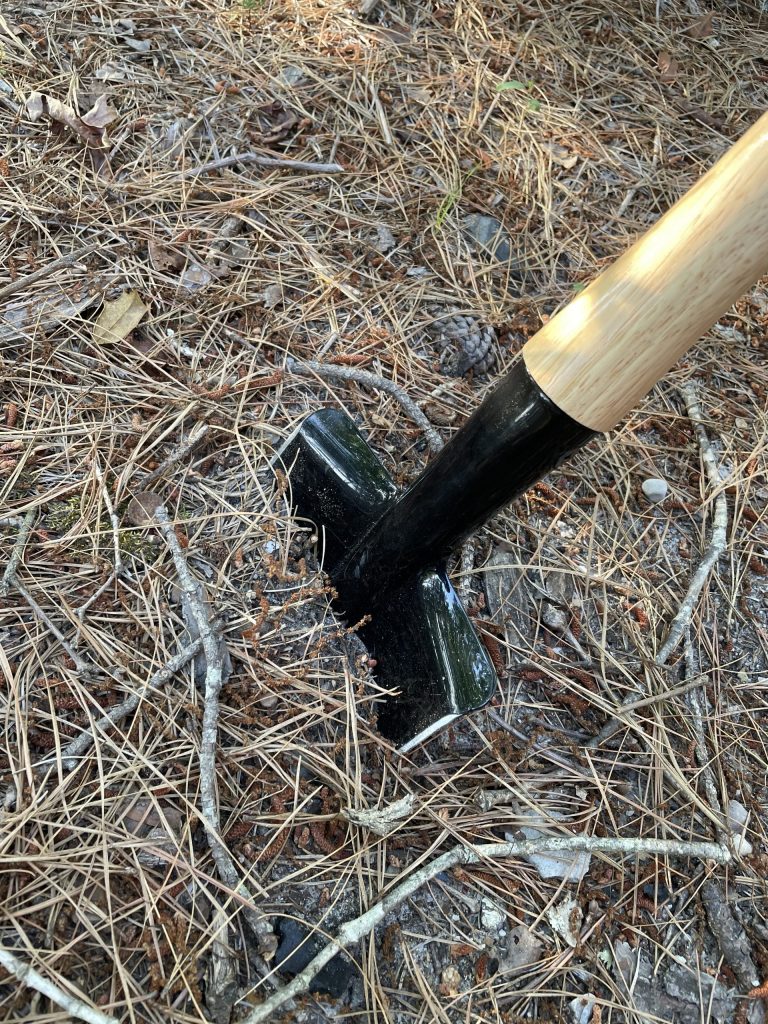
This will be very refreshing to you if you’ve ever been digging in wooded areas with a dull shovel, or a square shovel. Even a square shovel with a sharp edge usually balks at a thick root. The unique spade-esque shape of the Cold Steel Special Forces Shovel goes right through them. I was going through 1” pine roots like, well, like a sharp shovel through 1” pine roots. Seriously though, it was quite easy.
The shovel cuts through earth very effortlessly. You do need to stoop over to do it since the shovel is so small, but cutting and digging themselves are pretty easy. There’s something else to note here: the shovel has a very shallow scoop, so it’s actually not good for loading, carrying, or removing earth. It’s good at cutting, shaping, and moving, but not loading. You’ll go crazy trying to dig a big hole with this if you don’t have a shovel with a deeper scoop to help you remove the earth.
Speaking of that shallow scoop: it has quite a few advantages, actually. For one, the first thing I used this shovel for when I got it was to clear a sheet of ice off a flat surface. Because the edge was sharpened and there was minimal curve to the profile of the blade, it was very easy to slide it underneath the sheet of ice and lift it.

It can be used to cut through snow and ice, too, now that I think of it. I have not used it for that, but I am confident, given the ergonomics and design, that it would excel at that. It is an entrenching tool, after all.
This is one of the few tools that I imagine could be used to cut down and process a tree, then dig up the old stump, partially backfill the hole, and plant a new tree in its place.
I say this because the Cold Steel Special Forces Shovel is a born chopper. With its sharpened edge, you can easily cut through vines and limbs. I did this and am speaking from experience. Does it offer the same comfort and mechanical advantage as an ax or tomahawk? Certainly not, but then again, it does a lot better than those tools do.
Because of its nearly flat blade and good edge geometry, this shovel can be used to make deep, efficient cross cuts through wood grain. In this manner it can be used like an ax, machete, or parang for cutting through wood, or to remove small saplings.
Something I read about (although I have not put it into practice) is that some users apparently keep one edge of this shovel very sharp, for felling and clearing, and the other slightly more convex, for splitting. This is much like how loggers allegedly used to keep the two bits of Michigan patterned axes in different shape: one for felling and limbing, the other for bucking and splitting. You can apply the same principle to this shovel.
Now, about splitting. This thing is so awesome for that, seriously. I could not believe how effective it was at splitting wood. It actually surprised me, and it was the most pleasant revelation that came in the wake of the purchase.
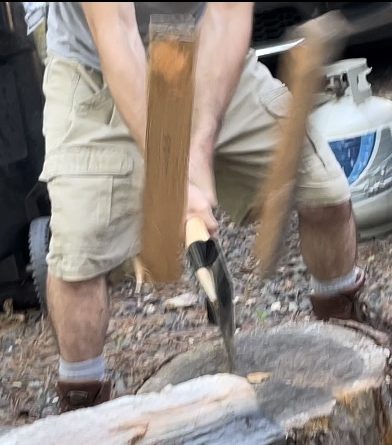
It is in no way as effective as a maul, an ax or a wedge, but it has just enough weight, and the blade is just straight enough, with practice, you can clear quarters of wood with a well placed swing. I split not only white pine and pitch pine with this shovel, but also quite a few pieces of white oak, and if you’ve split white oak, you know how tough it can be.
Don’t get me wrong; you’re not going to be processing whole, mature trees with just this shovel, but if it’s your only tool around a campfire and you need to split down the available wood just a bit more, you’d do just fine.
Another thing; the shovel can be used for just about anything that a knife can be used for. It comes with a pretty sloppy factory edge, but once you touch that up, you can use this shovel for cutting and carving. I can’t imagine fileting a fish with it, but if I’m being totally honest, I could think of worse tools to use to skin and clean small game. In fact, I’d confidently dress a squirrel or a rabbit with just this shovel.
As you can imagine, this shovel can be used for basic campcraft, such as carving wooden tool handles, spoons, or feathersticks. It’s going to be cumbersome, and you’d enjoy better dexterity with a smaller knife, but you could do worse than to be stuck with this shovel. That’s all I’m going to say.

Here’s another thing. Because the blade is wide and flat, you can use it for food prep. I could see it excelling at chopping fruits, vegetables, meats and cheese. You could even use it to spread condiments. I could imagine some users getting skittish about using it for food prep, especially using it to dig through the earth, but a tool is a tool. Your food grew up out of the dirt; as long as you clean the blade first, who cares?
One more observation. I haven’t used the shovel for this, but I know that, given it’s small size and relatively flat blade, it would be an excellent tool for manipulating a fire.
You don’t want to use a knife or even an ax to mess with coals because you can badly damage the temper of the steel which will predispose it to damage down the line.
However, I highly doubt the temper of this shovel is so fine that heating it will be an issue. The worst thing that would happen by exposing it to fire (probably) is that you’ll bring down the heat treatment a bit and the steel will start to anneal. But even then, that would only happen if you stuck it in a bed of coals and left it there. All I’m advocating for is to use the shovel as a fire tool. You can use it to adjust burning logs, bank fires, stack coals, and whatnot. I think it would do fine with that and wouldn’t suffer any terrible damage; nothing to write home about, at least.
While writing this I was reminded that the shovel could be used to strike fire from a ferrocerium tod, too. I didn’t try it but I know it would work, at least where the edge is exposed. If you’re worried about dulling the edge, expose a small portion of steel along the step or at the collar and use that as your striking zone. That really increases the overall versatility of this shovel and raises it to a new level. I hadn’t even thought about that before sitting down to draft this post.
So that’s quite a few things that the shovel can do, and can do very well. It goes far beyond its calling as a trench tool, but I’m fully confident that it would make an excellent entrenching tool, too.
Things Cold Steel Could Do Better?
Now that I’ve gotten all of that out of my system, I have to say there are quite a few things that Cold Steel could probably have done better in its Special Forces Shovel. Or, perhaps it’s not that they could be done better. For what it’s worth, I think it’s a truly awesome tool. It’s just that you should be aware of these things if you’re thinking of buying one.
Ergonomics are good but as I stated, the handle is a little bit slippery. This can be easily modded by the user with tape or cord, though.
The handle is a little bit short, but again, for what it’s worth, it’s highly versatile. The lack of a D-grip is as much of a benefit as a shortcoming, some I’m not sure how to frame that. Take it for what it’s worth.
I also wish Cold Steel sold these things with sheaths. They make a sheath for it but you need to buy it separately which I don’t appreciate. This is a bladed tool, and it’s sharp. Bladed tools should be sold with sheaths or covers.
The factory edge is pretty low quality. The grind is there, but it’s all burr-y or just flat out dull when you get it. I’m actually one of the few people that doesn’t seem to be bothered by this because I consider it the absolute responsibility of a tool user to sharpen a tool and keep it sharp. Just be aware of that, though.
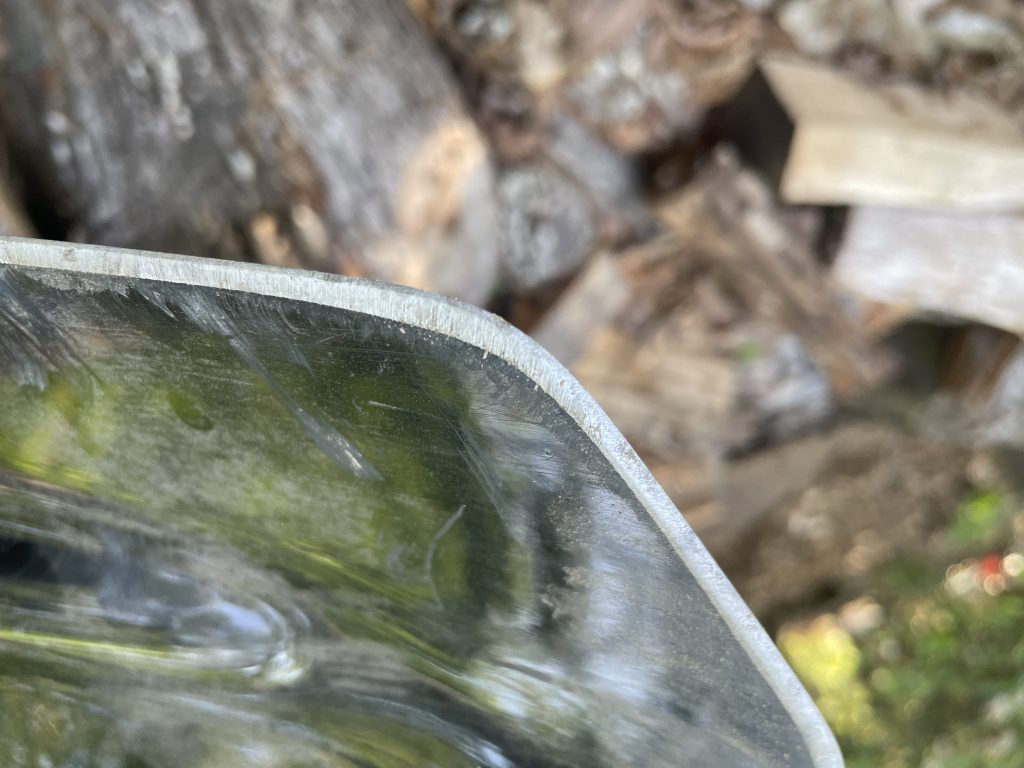
As I have expressly stated, grain orientation in the handle is beyond terrible. I’m not throwing Cold Steel any bones on this one. If it was a larger tool, I’d consider it unusable. Then again, for the price they charge, you might as well just take the blade and re-handle it. Thirty bucks for this little tool is quite worth it, in my opinion, and like sharpening, I consider re-hafting tools to be the responsibility of the owner.
The profile of the blade is very shallow, which is a curse as well as a blessing. While it is good for all of the things I mentioned, just be aware that shoveling material is laborious with this little shovel since the scoop has such a small capacity.
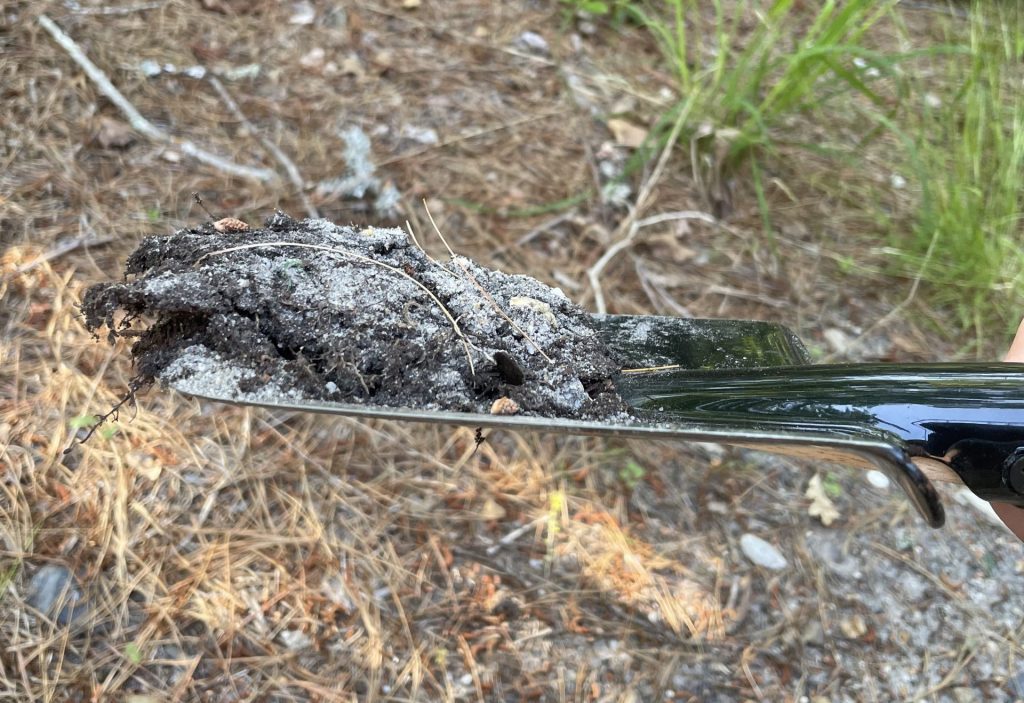
Then again, even brooking all of these concerns, you could do a lot worse wasting 20 or 30 dollars on something else. I say it’s a great tool and for the price I’d be surprised if you truly hate it.
Other than these few considerations, I really think this thing is a steal at this price.
Who Should Get One?

I personally feel like, at this price, there’s no reason not to get several of these things and stash them in places around the house, shop, or even to keep one in the trunk.
For a while, I kept both an ax and a scoop shovel in the trunk of my car. Things they helped me do: dig out of the snow (multiple times), clear a tree that had fallen in the way of launching a small boat, and clear and split tons of wood.
While I don’t keep one of these Cold Steel Special Forces Shovels in my trunk, but I think it would make a good trunk shovel. You never know when you’ll need to clear something out of the road or dig through mud or snow. I read a report from a guy that said he bought something like seven of these and kept them in his trunks and all over the house. At least he won’t be getting stuck in the snow.
Backpackers would be very well served by one of these shovels. They’re a little bit heavier than most ultra-light-gear fanatics will want to tolerate, but if you quit carrying a hatchet maybe you can replace it with one of these. These shovels are not as tough as hatchets but they are a thousand times tougher than folding trowels or e-tools.
On that note, this is an indispensable tool for a camper. Given the things you can do with it: digging fire pits, preparing fires, processing wood, preparing food, I feel like it’s an indispensable tool at a campsite. This makes them useful for hikers, campers (just like a Buck Compadre), and all sorts of outdoorsmen.
You could also just keep one in the garage, in the shop, in the shed or in the mudroom for the garden. There are a million and one uses for this shovel, as I’ve uncovered through this post.
At this point, even I’m excited to see what sorts of new trials I can tackle with this thing.
Happy digging (and chopping and splitting and carving and whatever else you can get into with one of these).
~The Eclectic Outfitter.